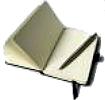Inventor Log

An inventor log (journal) or patent notebook is an important document for protecting your idea.
It is a journal or diary that is a written record of the development of your invention.
Ownership
The log establishes the conception date of your invention.
It is supporting evidence of your creation.
This patent notebook is a powerful legal document.
Patents have been disputed when others have claimed to have invented the product before the patent holder. This is not unusual because inventors can be working on similar inventions.
In most countries in the world, invention ownership belongs to the inventor who filed first for a patent. In September, 2011, the United States reformed it's Patent Act to create the America Invents Act. One of the major patent reforms was to change the "first to invent rule" and replace it with "first to file rule", meaning an inventor will be recognized for inventing a product if he/she files first.
Previously, an inventor who filed first for a patent had to also prove they invented it first and/or had to endure potential litigation on the "who was first" rule in order to validate their patent registration.
The America Invents Act provides an alternative procedure for contesting the validity of patent ownership with a process entitled "interference proceeding", which is an appeal process to the United States Patent and Trademark Office (USPTO) to determine entitlement to a patent.
Essentially, if you file for a patent first - you get the patent and if someone contests your ownership, they will have to initiate a interference proceeding.
How To Use
The log is a notebook that has stitched binding so that pages cannot be removed without being noticed.
This maintains the integrity of your journal because you are not able to go back and add or remove pages.
You can get a stitched notebook to use as a log anywhere school supplies are sold.
When you do anything that evolves and advances your invention idea - you write what you did in your notebook.
You write the date and time of your entries and then sign them. Use a pen. Never attempt to erase anything you write. If you want to correct something - draw a line through the entry you want to correct - then initial and date it - then write the correction.
Number each page of your patent notebook.
Witness
Have a trusted friend or family member witness the pages with their signature and date.
They must understand what they are witnessing so it should read: "Read, understood and witnessed by."
Ensure that any witness to your invention idea sign a non-disclosure agreement.
You can have them witness an experiment and the results. You can record the experiment in the log book and have witnesses sign it.
Details
Your log (patent notebook) should contain detailed hand written notes describing the development of your invention as well as sketches, drawings, results of experiments, materials used - everything.
 Write the names of any suppliers - keep all receipts, bills and correspondence in files.
Write the names of any suppliers - keep all receipts, bills and correspondence in files.
Keep all models, samples, prototypes you make and materials used. Sign and date them.
Record notes in your log of the time you spent thinking, solving problems, experimenting and researching.
Write in your inventor log what is unique about your invention, what uses does it have - what problems does it solve.
Record the benefits of various features of your invention. What advantages does your product have to other products.
Keep notes on how the product will be manufactured - keep notes on everything.
The log is also valuable as a record of your time. Many governments provide tax credits or rebates for research and development, which can be applied to revenues you may earn.
 Store your log in a safe and secure place. A locked fireproof safety box is good.
Store your log in a safe and secure place. A locked fireproof safety box is good.
An inventor log is an excellent tool for protecting the development of your invention idea and it would serve as evidence should you need to participate in an interference proceeding.


|
| Pilot flies over the Grand Canyon with jet engines attached to his back. |



